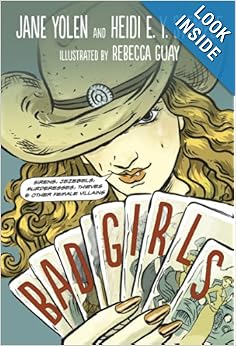 Harlot or Hero? Liar or Lady? There are two sides to every story.
Harlot or Hero? Liar or Lady? There are two sides to every story.
That tag line states the basic premise of this collection of tales about female villains and misunderstood molls of history. The book begins with Biblical bad girls Delilah, Jezebel and Salome, then moves on to Cleopatra, Anne Boleyn, Bloody Mary (Tudor), and my personal favorite: Countess Elisabeth Bathory, a Hungarian widow who did more than dabble in witchcraft. She killed hundreds of young women and girls so that she could bathe in their blood.
Actually, the story of Countess Bathory is a perfect example of the problem I had with this book. It’s lively and full of very human interest, but it’s also over-simplified and sensationalist, playing fast and loose with the known facts in the interest of engaging readers. In the chapters where I knew something bout the subjects, the story seemed just a tad embroidered. Here’s the Wikipedia take on “The Blood Countess”:
She has been labelled the most prolific female serial killer in history and is remembered as the “Blood Countess,” though the precise number of victims is debated. Her story results mainly from those who accused her and was apparently recorded more than 100 years after her death. It quickly became part of national folklore.
After her husband Ferenc Nádasdy’s death, she and four collaborators were accused of torturing and killing hundreds of girls, with one witness attributing to them over 650 victims, though the number for which they were convicted was 80. The purported witnesses testified to only 30-35 deaths. Supposedly due to her rank, Elizabeth herself was neither tried nor convicted, but promptly imprisoned upon her arrest in December 1610 within Csejte Castle, Upper Hungary, now in Slovakia, where she remained immured in a set of rooms until her death four years later.
And Wikipedia (not itself the most accurate source of information) later says that none of the witnesses actually said anything about the “bathing in blood” story. That tale grew up later. Although the authors discuss “context” over and over again in the cartoon summaries that follow each chapter in the book, there is very little context given in the text itself. But there is a lot of extra ahistorical information presented as fact.
Delilah is described as “young, beautiful, smart and sly” with “sexy eyelashes.” Then the authors tell us that after betraying Samson to the Philistines, “Delilah took her silver coins and left quickly.” The problem is that Judges chapter 16, the only historical source for the story of Delilah and Samson, says nothing about Delilah’s appearance or sexiness and nothing about her escape, although they could be deduced.
In the story of Jezebel, Jehu, the rebel commander gets a new line. Instead of saying “throw her down” when he orders the death of Jezebel, in Bad Girls he says, “Throw the witch queen down!” It’s much more dramatic, but not accurate according to, again, the only source for the story.
In Bad Girls, Salome is said to have danced the “dance of the seven veils.” The Bible simply says she danced. Oscar Wilde and Richard Strauss are the ones who added the “seven veils.”
Mary Tudor “hated the red-headed baby Elizabeth,” according to Stemple and Yolen. Really? Is there any evidence for this supposed hatred? One source I read indicates that Mary at least tolerated Elizabeth and taught her little sister to play the lute, that the two exchanged gifts and played cards together. Others say that Mary seemed fond of Elizabeth as they were growing up, but when Maary became queen and various Protestant plots to put Elizabeth on the throne in her place came to light, Mary understandably began to distrust her ambitious half-sister.
So, as the book continued with such infamous bad girls as Bonnie Parker, Calamity Jane, and Typhoid Mary, I was never sure exactly how factual and how fanciful the details of the stories were. In their introduction to Bad Girls, IF the authors had told us that these were their own versions of the stories of these women, what they imagined might have happened, I would have been much more comfortable with the book. It did get me interested in some of the women I had never heard of or didn’t know much about. I just think this book blurs the lines between fact and fiction too much, and the untrustworthiness of the narrative makes it of dubious value for readers who want to know what really happened.
Oh, and by the way, Bad Girls is not a graphic novel or “graphic nonfiction” despite the cover (great cover!) and the cartoon panel at the end of each bad girl story.
Pingback: Sunday Salon: Books Read in October, 2013 | Semicolon